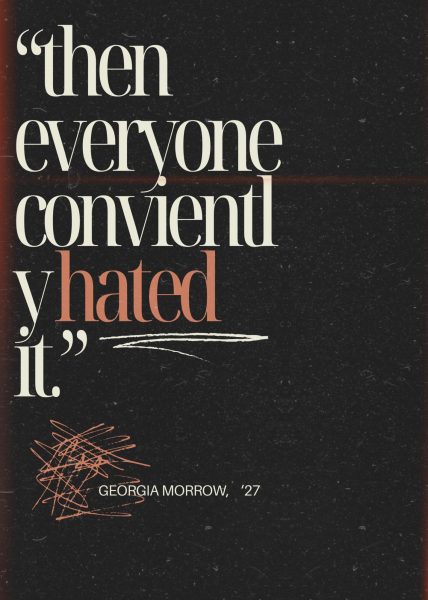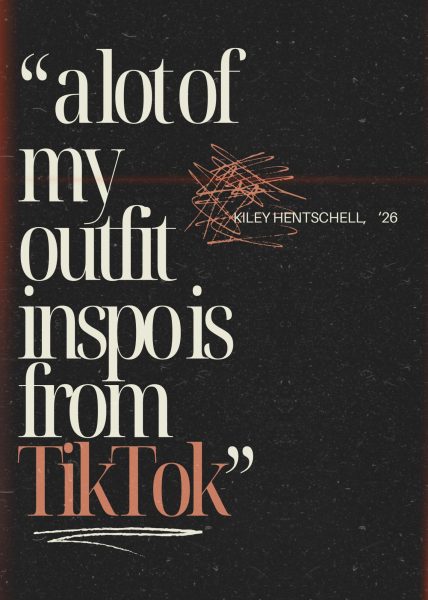Initial Overview
The media is a widespread phenomenon that has been presented in many different lights. With the positive aspects, negative ones are also evident.
One of these encourages consumption. From apps like TikTok or Instagram, people are actively exposed to “the next new thing”. In many ways, social media acts as an extensive source for advertising and marketing—a tool that benefits many large companies and small businesses.
However, when this tool is utilized effectively, it engages people into purchasing products and services, which are likely to “die out” next season. With companies continuously producing these products, social media influencers draw attention to consumption and market trends as a necessity to living a fulfilling and profound life.

What are microtrends? What do you consider a microtrend? Do you think social media influences the popularity of microtrends? Do you follow microtrends?
How can microtrends be identified? Think of your favorite pair of shoes—now imagine plastering them with trendy prints and designs. In two months, the media has already decomposed this style with newfound disapproval, labeling it as “basic” or “overused”. Suddenly, the next pair of trendy, up-and-coming sneakers are circulating the internet with countless amounts of praise, and the cycle repeats.
Welcome to the loop of the microtrend. The loop where you’re convinced you absolutely have to have something, only for it to be frowned upon in a short period of time.
Through student interviews, many affirmed that microtrends are existent in high school. “Microtrends are definitely a thing.” States Sophomore Georgia Morrow, “Specifically camo, bows, cheetah print, like [these trends] came quickly into style and everyone confidently hated them rapidly after they began to be popular”.
Many students also found that they were a part of the microtrend cycle, following clothing trends, even with knowledge of them fading out of the “fashion loop”.
Do you feel like there’s a pressure to keep up with latest trends? Where students get outfit inspo
As highschool students, we are often exposed to these trends on a daily basis—primarily through social media apps, peers, and even high fashion brands. “I think that with our generation, there’s definitely a pressure because of TikTok and Instagram.” Said Junior, Kiley Hentschell.
Influencers on TikTok serve as a huge marketing boost to many companies.
Current senior, Stella Wiggins, includes, “you see it on your social media constantly, and when you see a bunch of people wearing it and you’re like, oh that’s cool, I want to be like that too. Like you want to be your favorite influencer…if somebody’s telling me to buy it, I buy it.”
Many students explained that social media heavily influences their purchasing decisions, as well as where they find most of their outfit inspiration.
An attending Junior, Vanessa Pizarro reveals, “A lot of my outfit inspo [comes] off of TikTok.” When asked, a popular application that students claimed to receive outfit inspiration from was Pinterest.

What trends did you think would be popular, only for it to die out quickly? Do you regret any of your purchases? How do you decide whether or not to buy something? Students evaluate want vs. need.
With objects and products being advertised as fulfilling, people, as young as middle schoolers, spend large quantities of money to be active with current trends.
Upon asking students at Bellarmine if they had ever had any regrets towards a purchase driven by a trend, many of them said that they had. “I definitely have. Oh yeah, the panda dunks. I got those and was obsessed with them. I wanted them so bad and when I bought them, I probably wore them for freshman year. Now they just sit there.” Hentschell claims.
When asking all the interviewees if they could recognize any specific trends they thought would be popular, and ended up declining quickly, many of them provided several examples. Morrow acknowledged that one specific style, the “Y2K style”, where she further explains that “it was very summer 2024, and now it’s gone—which is kind of sad.”.
Along with these trends being briefly included and excluded from the fashion cycle, Bellarmine students offered words of advice on how they commit to purchases and how they differentiate what they need versus what they want.
Hentschell explains how she has an app that she utilizes to track her wish list of items. “I let it sit and if I go back to it in a month or two. If it’s still something that I really want, I’ll buy it. If I don’t come back, then I’ll just remove it from the list”.
For other students, however, some made statements regarding the sudden increase in prices of clothing.
“I try my best not to waste money because I have a lot of important things that I have to buy. So when it comes to personal items, I think I have to be very strict about what I decide to buy for myself.” States Pizarro.
While many students are aware of the importance in being aware of where their money is spent, the media actively contributes to encouraging overconsumption culture—which many of these students agreed to be extremely problematic.
A deeper dive into Overconsumption culture
“If I like it, I’ll just grab it in a different color”. The widespread popularity landscaping the world of consumption is exhibited to its extreme through the media. Not only do you need this pair of shoes in black, but you need them in white, red, blue, yellow, green…but why?
The media gives off an impression that the more you have, the more fulfilled you will be. Many students confirmed that it is not uncommon to become fixed on the idea of wanting more than you need. This isn’t a new phenomenon, though. This idea has existed for decades.
In the MIT Press Reader, their article, “A Brief History of Consumer Culture”, Kerryn Higgs overviews the history of consumption in America, dating back to “before World War I” in the 1920s. After the ending of the Great War, “U.S. production was more than 12 times greater in 1920 than in 1860”. Employment and unemployment, as well as longevity in hours spent increasingly changed and developed, paved the way for mass production of goods and services.
However, with this substantial shift in production, the demand for consumers to purchase products excessively increased. Historian Frederick Allen wrote, “Business has learned as never before the importance of the ultimate consumer. Unless [the consumer] could be persuaded to buy and buy lavishly, the whole stream of six-cylinder cars, super heterodynes, cigarettes, rouge compacts and electric ice boxes would be dammed up at its outlets.”
Nevertheless, consumerism is a current and heavy problem that America has been programmed to adapt to. When interviewed, Hentschell mentions a quote that she holds true to. “We’re so connected to the things that make us disconnected”. She continues, “I think that overconsumption has programmed our brains to care about things that, at the end of the day, are the least of our priorities…if you look at the big picture.”
Solutions and Alternatives
With the complexity of understanding personal finances and how they are intertwined with the student desire of trend-approved self-image, solutions and alternatives are crucial to break free from the cycle and involve students in making more conscious choices about what they purchase and why. For students with an eye for creativity and mindfulness towards environmental sustainability, thrift shopping is a fantastic way of exploring personal style, engaging in the trend cycle, while minimizing excess production and overconsumption of clothing or products.


